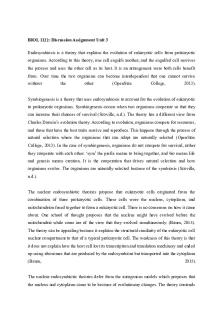BIOL 1122 UNIT 1 DF Number 1 PDF

| Title | BIOL 1122 UNIT 1 DF Number 1 |
|---|---|
| Author | Timmy Sarah |
| Course | Biology 2 for Health Studies Majors |
| Institution | University of the People |
| Pages | 2 |
| File Size | 79.9 KB |
| File Type | |
| Total Downloads | 30 |
| Total Views | 152 |
Summary
UNIT 1 BIOL 1122 DISCUSSION ASSIGNMENT 1...
Description
BIOL 1122: Discussion Assignment Unit 1
Evolution is the source of diversity on earth. Is because of evolution that we see in our world multiple kinds of creature and living organisms. There are two ways in how adaptive traits occur divergent evolution and convergent evolution.
Divergent evolution is when the species develop in a different direction, but they share a common starting point or ancestor (OpenStax, 2016). An example of this kind of evolution is primates. This divergent process happens multiple times during earth history. In this activity, I will focus on a division dated 25 million years ago where the simians divided in between new world monkeys and old-world monkeys.
Both groups of monkeys share a common ancestor. “It is speculated that the two groups underwent divergent evolution because of allopathic speciation. As the continents of America and Eurasia had by this point separated, the split could have been caused by a chance migration across the Atlantic Ocean.” (Editors, 2017) As a result of the divergence, Platyrrhines appear in central America with characteristics as flat noses, long tail that act as a fifth limb and can be used for climbing. Such as spider monkeys and capuchins. Catarrhini is the old-world monkeys develop in Africa and Asia with a wider amount of adaptability into multiple environments. From there come the baboons and ancient Hominoidea the ancestor of the great apes: chimpanzee, gorilla, and the first humans.
On the other hand, is convergent evolution similar genotypes appear in distantly related species (OpenStax, 2016). Is when two species despite being distantly related develop a similar trait. One particular example is the fingerprints of humans and koalas. Despite not having a common ancestor in more than 70 million years the little marsupial has almost exact fingerprints like humans. This comes for the mutual need of grasping. Ancient apes develop fingerprints to improve their ability to handle tools thanks to that need today we have unique fingerprints. The koalas feed themselves by climbing into branches of eucalyptus, so their skin evolves into these fingerprints to allow them to climb easy and develop precisely fine control for this basic feeding task.
Speciation “which works for sexually reproducing organisms, is a group of actually or potentially interbreeding individuals.” (OpenStax, 2016) is impacted by divergent evolution. As the new specie share a common ancestor, the evolution change when the ancestor disappears, and the new offspring genes start becoming incompatible splitting the new species.
References: Biology from OpenStax College. (2012, August 22). Retrieved May 9, 2020, from http://cnx.org/contents/[email protected]:1/ Editors, B. (2017, April 28). Divergent Evolution. Retrieved September 03, 2020, from https://biologydictionary.net/divergent-evolution/
Wolchover, N. (2011, May 03). Koalas Have Human-like Fingerprints. Retrieved September 03, 2020, from https://www.livescience.com/14007-koalas-human-fingerprints.html 456 words...
Similar Free PDFs

BIOL 1122 UNIT 1 DF Number 1
- 2 Pages

Physics 1122 - Lab 1 2015
- 1 Pages

BIOL 1301 Unit 1 - Self Quiz
- 3 Pages

Assignment number 1
- 1 Pages

TED Talk Number 1
- 1 Pages

Reading - number 1 lectu
- 2 Pages
Popular Institutions
- Tinajero National High School - Annex
- Politeknik Caltex Riau
- Yokohama City University
- SGT University
- University of Al-Qadisiyah
- Divine Word College of Vigan
- Techniek College Rotterdam
- Universidade de Santiago
- Universiti Teknologi MARA Cawangan Johor Kampus Pasir Gudang
- Poltekkes Kemenkes Yogyakarta
- Baguio City National High School
- Colegio san marcos
- preparatoria uno
- Centro de Bachillerato Tecnológico Industrial y de Servicios No. 107
- Dalian Maritime University
- Quang Trung Secondary School
- Colegio Tecnológico en Informática
- Corporación Regional de Educación Superior
- Grupo CEDVA
- Dar Al Uloom University
- Centro de Estudios Preuniversitarios de la Universidad Nacional de Ingeniería
- 上智大学
- Aakash International School, Nuna Majara
- San Felipe Neri Catholic School
- Kang Chiao International School - New Taipei City
- Misamis Occidental National High School
- Institución Educativa Escuela Normal Juan Ladrilleros
- Kolehiyo ng Pantukan
- Batanes State College
- Instituto Continental
- Sekolah Menengah Kejuruan Kesehatan Kaltara (Tarakan)
- Colegio de La Inmaculada Concepcion - Cebu









